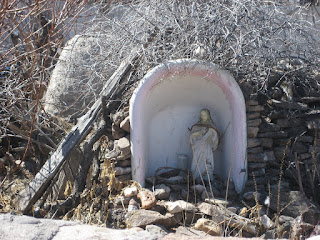General view of the island Neveranger, 1911, Adolf Wolfli;
image source wikimedia commons
The photo above shows Art Brut artist
Adolf Wolfli. Adolf spent much of his
adult life in a Swiss insane asylum after
being judged a danger to society.
image in the public domain
The connotation for "outsider art" encompasses a much broader category of artist. Although still considered to be uninfluenced by traditional art culture, and untrained in the arts, the outsider artist may not live quite so far out on the fringes of society.
This work, by Gaston Chaissac, was sold
at auction for four thousand Euros in 2007.
Gaston was considered by many artists of
his time to be an outsider artist, however
he viewed himself as a rustic modern artist.
Chaissac was neither untrained in the arts,
nor uninfluenced by the arts, and often
referred to himself as Picasso in clogs. Learn
more about Chaissac on PBS.org, here.
Wax crayon on cardboard, Leroy Person
A well-known outsider artist, Leroy Person
often combined images of tools and plants
into the same piece.
Image source, luisrossgallery.com, found here.
Another work by Leroy Person.
Part of why Person's work was considered
successful, is his intuitive use of rhythm,
balance, light, and shadow.
The work shown above incorporates
a child's drawing, and wood from an
old packing crate. The reverse side of
the piece is carved and painted red with
some blue and yellow. Notice that the
artist allowed some of the original writing
from the crate to show through, and that he
carved plant and tool motifs into the wood
before painting. Multi-media, Leroy Person.
Learn more about Leroy Person, here, at
Images source: George Jacobs' self taught art website, here.
Mother and Child, mixed-media, by self-proclaimed
outsider artist Benton Lutz. Although his work is
good, and this piece is undeniably beautiful, the
fact that Lutz is aware enough of the outsider artist
genre, to classify himself and market himself as such,
makes one wonder if perhaps another categorization
might suit him better.... This piece can be purchased
on the artist's website, here.
An all-time favorite outsider artist is James Hampton, a janitor, who worked diligently for fourteen years creating his sculptures. He worked quietly, and few people were aware of his obsession until after his death. He left journals and papers indicating that Moses had appeared to him, and he was building his assemblage of liturgical objects as a monument to Jesus in preparation for his ministry as St. James.
The Throne of the Third Heaven of the
Nation's General Assembly, mixed-media
sculpture, James Hampton. See this image
and read a very good essay about the artist
written by Lynda Roscoe Hartigan, here.
Image, Smithsonian Institute, via here.
Shown below is an image from one of Hampton's journals. He often wrote in a special code of his own creation.
Hampton is shown here in the garage he rented in which to build his sculptures.
Hampton's sculptures were created using kitchen foil, cardboard, foil labels from beer bottles, carpet tubes, and other found materials.
Jimmie Lee Sudduth is considered by many to have been an outsider artist. As a child, he felt compelled to create art, and even experimented with creating his own pigments from clay and plants. He learned to paint using his fingers, and continued to use them as an adult, claiming his fingers never wore out.
Cotton Gin, sweet mud paint on board, Jimmie Lee Sudduth
Vintage City Scape, sweet mud paint on board, Jimmie Lee Sudduth
No discussion of outsider art would be complete without mentioning Donald "Cano" Espinoza, of Antonia, Colorado.
Cano's life work is represented in the home he has created using beer cans, hubcaps, and other found materials.
Cano credits his inspiration to vitamin "M" and Jesus.
A Native American Vietnam vet, his castle is a monument of thanksgiving to Jesus for keeping him safe and bringing him home. He uses repurposed materials, creatively adapting items for new uses.
Although, the bathtub virgins are not unique to outsider art, they are definitely a great example of adaptive reuse.
As you can see here, Espinoza is not shy about sharing his world view!
As you can see here, Espinoza is not shy about sharing his world view!
This post is being linked to Alphabe-Thursday, at Jenny Matlock's blog.





















































